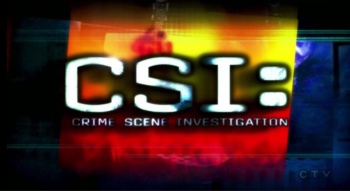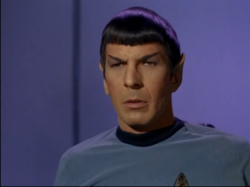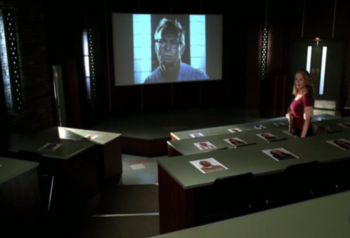WOO IN REVIEW: CSI – One to Go
(CBS)
I have held off on berating CSI: Crime Scene Investigation for quite some time, mostly because it, at the very least, promotes science and the evidence obtained from scientific practices as the best way to solve crimes. Whether or not they were totally accurate in their views on science was inconsequential – the CSI writers went forth armed with fingerprinting kits and computer displays that for some reason show an image of every single fingerprint in the entire database when matching a comparison, running the CPU so hard that the computer itself would, quite possibly, burst into flames, leading the CSIs to wonder if they had a case of arson on their hands and take fingerprints and feed them into a computer and... well, you see what I'm saying here. It's weird that every computer in CSI has not already been reduced to charred rubble.
kits and computer displays that for some reason show an image of every single fingerprint in the entire database when matching a comparison, running the CPU so hard that the computer itself would, quite possibly, burst into flames, leading the CSIs to wonder if they had a case of arson on their hands and take fingerprints and feed them into a computer and... well, you see what I'm saying here. It's weird that every computer in CSI has not already been reduced to charred rubble.
And CSI has taken a few hard hits in the past couple of seasons. Sara Sidle, my least favorite character, did not die horribly at the hands of The Miniature Killer, who turned out to be incredibly lame. Gary Dourdan, who played Warrick Brown, was caught with a veritable pharmacy of illegal drugs leading to his character's untimely death. They introduced the character Riley Adams to re-up the annoyance gap that Sara Sidle's departure left.
But there was one remaining part in CSI that was good – the character Gil Grissom, played by William Petersen.
Unfortunately, Petersen can recognize a sinking ship when he sees one. Rather than go down with the Titanic, Petersen opted to request a contractual release and end his part in the show.
The final episode he appeared in, One to Go, aired last night. It was the second in a two-part Who-Is-The-Serial-Killer's-Accomplice CSI spree. This review concerns only the second part, though I have seen both. (The first is titled 19 Down.) It only contains the second because the science in that particular portion was so shockingly abysmal that I think my eyebrow might permanently be raised.
My sister and I sat down to watch One to Go with a box of Kleenex, assuming that this would be the most awesomely tear-jerking, freaky episode of CSI since Tarantino's two-parter Grave Danger, where CSI Nick Stokes was stuck in a Plexiglas coffin and covered in ants.
It was not. Not a tear was shed for Grissom.
Was it David Hodges' fault? Well, partly. Hodges, who used to be a background character that you loved to hate, has obviously recently been noticed by a CSI writer who said to themselves, “You know, this guy needs to be deeper,” and then went about trying to give him heartfelt lines while maintaining the dickishness that had come to define him.
Hodges had the pleasure of being the last CSI Grissom spoke to before leaving for good. And, in what I can only describe as 'cliché diarrhea,' said lines like “We are the thin blue line between order and chaos,” apparently forgetting that less than four minutes previously Grissom had pointed out to another character that CSIs are not the police.
He added that “you take yourself out of the equation, it's the butterfly effect!”
I cannot even fathom what he meant by that. A butterfly flaps its wings and... Grissom quits CSI. Grissom quitting CSI is like a butterfly flapping its wings? I think the editors made a minor misjudgment in letting that line slip through and that what he really meant was the domino effect, but hey, whatever. He might've meant the Ashton Kutcher movie.
But the part of this episode that bugged me the most wasn't the fact that the writers spent about as much time on it as they might spend on, say, ordering a latte at Starbucks. It wasn't the fact that, at the end of the episode, Grissom is seen reuniting with Sara Sidle after following his GPS, which simply says “Costa Rica.”
I think we were supposed to feel sad at that part, but, as my sister pointed out, “I have Google Maps on my phone, and it's never like... 'Hey, you're in America. Just so you know.'”
It was the science. The ridiculous science that still has me looking like Spock because my eyebrows are now affixed permanently in 'questioning' mode.
And in this, there were a few things in particular that seemed completely impossible to me. I have spoken with other individuals who I believe are more knowledgeable than I am to make sure I'm not the one who's an idiot and cannot follow the genius that is CSI. If any of us are wrong about the science, though, and if it can really be done, please send information on how the feats discussed below could be accomplished to This email address is being protected from spambots. You need JavaScript enabled to view it., and your response will be posted in the next Woo in Review.
As I said, One to Go is devoted to attempting to find the accomplice of an imprisoned serial killer. If CSI simply approaches the killer, Nate Haskell (The Dick and Jane Murderer), he will balk and refuse to give any information. However, like any good serial killer, he loves the limelight, and was recently invited to speak at a class on serial killers via webcam.
The class, conducted by Dr. Raymond Langston (played by Laurence Fishburne, who it appears will become a part of the CSI team), is attended by Grissom, who pretends to be a visiting professor interested in the subject.
As the case unravels, the CSIs realize that the accomplice must have been in the classroom during the webcam conversations with Haskell. Haskell's end of the conversation was recorded on video, but the reactions of the classroom were not. There is only a transcript of questions that were asked, and no notes about who asked them.
After reviewing the transcripts, the CSIs feel that they can tell who the accomplice was from some of the questions asked, which were about methods of subduing victims. The CSIs then assume that, at this point, the serial killer (remember: imprisoned and being broadcast via webcam) probably looked at his accomplice when giving the answer.
The CSIs then line up the angle of the eyeline of the serial killer with the auditorium the interview was broadcast to and pinpoint the seat location of the individual who must have been the accomplice.
At this point you should have your eyebrows raised and say “Wait... what?”
Keeping in mind that this interview was conducted via webcam, imagine the setup it would take to figure out where the killer was looking in the auditorium.
There isn't one.
Webcams are not windows, and webcams are not virtual reality. On my computer, for instance, the webcam is located at the top of the monitor. If I am in a two-way conversation with someone and can see them on video and they can see me (which is stupid in and of itself, because why would you allow a serial killer to look at a room full of potential victims), and I am looking into the camera, I am not looking at anyone. I am looking at the camera. If I am looking at the camera, then I cannot see the video feed. If I am looking at the video feed, then I am not looking into the camera. 
The angle of my sightline is irrelevant, because I am not actually looking into the room. At absolute best, you might be able to tell what side of the room I was trying to look at (the auditorium in the episode is huge). And even then, only if the webcam was pointing at me straight on. The killer and the accomplice could not make eye contact. A video feed is not the same thing as eyes.
This wasn't some little side note that they threw in as a small part of the mystery, either. This was the piece of information that led them directly to the accomplice. Unfortunately, when they tried to go visit him, he wasn't home. They did, however, search the accomplice's home and find a stash of drugs they believed had been used to subdue the killer's victims. They ran the fingerprints on the jar (yes, the guy really kept his drugs in a glass jar) through their database and found a match to a drug dealer who they figured would probably know the secret killing location the accomplice was using.
Unfortunately, when police tried to confront the drug dealer, he ran. And for some reason – even though this chase was on foot, even though the police cars were going roughly thirty miles per hour and I assume the brakes and steering were still functioning – a patrol car hit the drug dealer, killing him instantly.
It's almost comedic, isn't it?
Well, no bother. In addition to the drugs found at the accomplice's house, CSIs also discovered videotapes shot by the original Dick and Jane murderer of his crimes. Luckily, one contained a brief shot out the window where the videos were filmed. The shot was blurred, and showed only two mountain peaks (not the base) and the moon in between. It was timestamped at the bottom.
Grissom, after reviewing the video, asked for a still of the shot out the window. They then cleaned up the still photograph, which made about half the stars disappear but showed in more detail the two mountain peaks and the moon, which was waning gibbous.
Unfortunately, no one could recognize the location. How could they? A blurry photo of two peaks and the moon could have been taken pretty much anywhere that has mountains.
But no worries – Grissom said, “You know, those peaks look like they're roughly the same height.” CSI Nick Stokes brought up a topographic map on the screen, and pinpointed a location with two mountain peaks that were the same height. Location found. Off to capture the killer!
“Wait... what?”
How could Grissom tell that the mountains were the same height? Is he magical? The shot is a still photograph, shows only the moon and two mountain peaks, and not the base of either.
I spoke with Phil Plait regarding the content of the photo. At the time, I did not have the images from the episode, and he had not yet seen it. I gave him the information from the episode that I could remember. 
“If it were a super high quality photo, then you could magnify the Moon, look at exactly where the terminator was (the line between day and night) and know when the photo was taken pretty accurately, but that doesn't give you a location, just a time,” he said.
Within the episode, Grissom's reason for trying to determine the location this way did have to do with astronomy. Grissom cited photographer Ansel Adams, who died in 1984. Many of Ansel Adams' photographs did not have dates to say when they were taken – Adams often forgot to write that information down.
In 2005 – and this is true – astronomers from Texas State University used information from lunar tables, topographic maps, weather records, and astronomical software to determine the date and time Ansel Adams took the photograph Autumn Moon.
“We know when this was made,” Grissom said, speaking of the still from the DJK video, “maybe the moon can tell us where.”
The only unfortunate side is that it can't. It can't determine height, and it can't determine distance.
“One mountain could be twice as high and twice as far away. Shadows might work, maybe. I could probably dream up a way they could, but if they didn't mention shadows then I can't see how to do this,” Plait said, “Imagine it this way... you have a 12,000 foot mountain 12,000 feet away, and a 14,000 foot mountain 14,000 feet away. They would look pretty much the same height. Now put your friend in the photo 10 feet away. Does that help you determine the distance to the mountains? Nope.”
CSI didn't even attempt to dream up anything with shadows. The photograph could be comparable to forced perspective, an optical illusion wherein two objects appear to be vastly different sizes because one is further away than you think it is. The Lord of the Rings trilogy employed this method as one of the many ways to make hobbits look small. Check out a video of that here.
I ran this information by Jeff Wagg as well.
“The only way that photo is going to help is if there's a sculpture of Washington, Roosevelt, Lincoln and Jefferson on one of the mountains,” Wagg said.
In CSI-land, though, investigators were able to identify the accomplice and his location AND kill him seconds before he murdered the woman he was holding captive.
Oh, and his death was filmed in bullet time, just to top off the nightmare.
CSI: Crime Scene Investigation – One to Go: 1 out of 5 stars.
RECOMMENDED READING:
Forensic Science: The Basics by Jay A. Siegel
JREF Swift Blog
WOO IN REVIEW: CSI - One to Go
- Details
- Written by Alison Smith